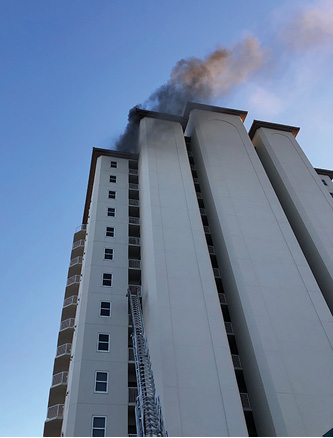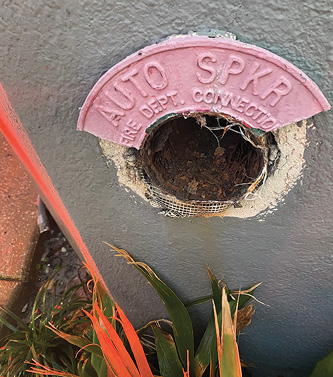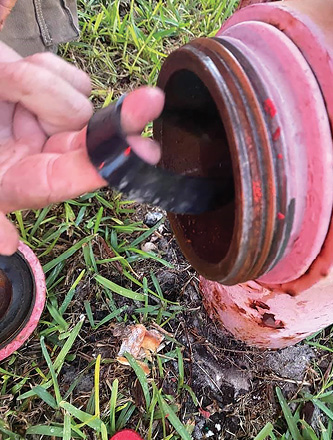By Nick Peppard and Mike Hall
On November 19, 2020, Navarre Beach (FL) Fire-Rescue, Holley-Navarre Fire District, and Midway Fire District were dispatched to a high-rise fire on Navarre Beach, a renowned vacation destination on the Florida’s Gulf Coast. The call was received at about 1556 hours and, on dispatch, Navarre Beach Fire-Rescue’s deputy chief requested a box alarm for a residential high-rise fire. On arrival, companies found smoke coming from the roof of a 14-story condominium and immediately requested a second alarm assignment (photos 1, 2).
A Rude Awakening
While companies were making their ascent to the fire, driver-engineers were assigned to supply a fire department connection (FDC). The engineers were aware of the code requirement that a hydrant must be within 150 feet of an FDC. This information is vital since bushes often conceal FDCs, especially wall-mounted FDCs. Accordingly, if a hydrant is close to a building, then the FDC is likely nearby.
While an engine was connecting to a hydrant, personnel stretched two three-inch hoselines to the FDC, but they were in for a rude awakening. While they were making connections to the wall-mounted FDC, the entire siamese connection fell off the side of the building. Waterfront buildings located on the Gulf of Mexico are exposed to the brutal effects of the hot Florida sun, salty air, high humidity, saltwater, and sand from hurricanes that have flooded the barrier island many times over the years (photos 3-4).
- Standpipe 101, Part 1: A Beginner’s Guide to Standpipe Firefighting | Part 2 | Part 3 | Part 4 | Part 5
- Bill Gustin on Standpipe Operations
The hydrant was the next point of potential failure. Apparently, a gasket that seals the valve and stem assembly became dislodged and wrapped itself around the stem of the hydrant (photo 5). This was discovered after the fire but raised concerns as to the possibility of it partially occluding the apparatus pump intake.
Plans B, C, D, …
Since pressurizing the FDC (plan A) was not possible, Command considered other options for getting the water to the fire:
Flying standpipe. This option involves raising an aerial device and using its prepiped waterway to supply hose stretched by the stairwell the rest of the way to the fire floor.
Supplying a second FDC. According to National Fire Protection Association (NFPA) 14, Standard for the Installation of Standpipe and Hose Systems, high-rise buildings shall have at least two remotely located fire department connections for each standpipe zone.
Connect supply lines to first-floor standpipe hose inlets if they are not pressure reducing valves (PRVs). PRVs limit standpipe (both static and residual) outlet pressures from exceeding 175 pounds per square inch (psi) by responding to the pressure downstream of the outlet. Consequently, attempting to pump “upstream” into a PRV will close its piston/plunger assembly as if it were a one-way check valve. PRVs are set at the factory or adjusted in the field predicated on the building’s fire pump’s “churn” pressure (no water flowing). A building’s fire pump does not vary its pressure depending on the elevation of the fire floor. A fire pump operates at one pressure, enough to overcome friction loss in the standpipe; head (elevation) pressure of the water column in the entire height of the standpipes; and, in post-1993 buildings, 100-psi residual (flow) at the roof.

(1) Photo by author.

(2) Photo by D.J. Stone.

(3) Photo by Fire Marshal Joe Early.

(4) Photo by D.J. Stone.
Accordingly, the pressure-limiting effect of a PRV hose outlet at the first floor is greater than at an upper floor where the head pressure is lower. As a result, at levels where system pressure does not exceed 175 psi, it is not uncommon to find conventional hose outlets at upper floors. This presents another option for firefighters: raise, lower, or stretch hose to the lowest floor without PRVs and pump into a conventional outlet.
If first-floor outlets are PRVs, pressurize the building’s fire pump test header. This will require entering the fire pump room and opening the control valve to the test header.
Well-stretch hose from the pumper up the stairwell opening. Although a traditional stairwell stretch—i.e., laying hose on stairs—may be effective for fires on lower floor fires where you need to negotiate only a couple of flights of stairs, this method requires a substantial amount of hose and personnel to move and manage the hoseline if a fire is on an upper floor. Consider that a traditional stairwell stretch on return stairs requires as much as one 50-foot section per floor, plus the hose stretched from the apparatus to the base of the stairwell, plus the hose needed to reach from the attack stairwell to the fire compartment, and another 50 feet of hose for the nozzle’s stream to reach all points in the fire compartment. For example, for a fire on the seventh floor, a conventional stairway stretch could require as much as seven lengths or 350 feet just in the stairwell.
Standpipe Systems: Stretching from the Street
The well stretch allows firefighters to use significantly less hose. For example, you would need as little as 70 feet of hose to reach the seventh floor. There are considerations when employing a well stretch.
First, the hose must fit in the well hole opening. A good rule of thumb is as follows: If a gloved hand can fit comfortably in the well hole opening, it is large enough for a 2½-inch hose to pass up through the well.
Second, charged hose is heavy, weighing 138 pounds per 50 feet of charged 2½-inch hoseline. Once the hose reaches its destination floor, usually the floor below the fire, continue to pull sufficient hose to ascend to the fire floor, to reach from the attack stairwell to the door of the fire compartment, and to enable the nozzle’s stream to reach every point within the fire compartment. Use a short section of rope or nylon webbing to tie the hose off at the destination floor. For well stretches ascending several floors, “lighten up” the hoseline by tying it off below the couplings every four or five floors to help spread the load evenly along the ascent if possible. If the hose is only tied off at its destination floor, then its weight will be concentrated on a single point. This may pinch off the hoseline, restricting water flow, or it may cause a section of hose to pull out of its coupling. These are crucial details when considering the next option.

(5) Photo by Michael Hall.

(6) Photo by author.

(7) Photo courtesy of Miami-Dade (FL) Fire Rescue.
Hoisting or lowering a hoseline from the floor below the fire. This may be a better option even if the standpipe system is in perfect condition because firefighters can rely entirely on their own equipment. Few evolutions are faster than dropping a rope bag and hoisting a hoseline from an apparatus positioned directly below the hoisting point. As mentioned, when hose is hoisted or lowered several floors, the weight of the charged hoseline tends to form a kink where it passes over a windowsill. Additionally, you may not be able to support hose suspended on the side of a building at intermediate levels.
To prevent the hose from kinking as it passes over a windowsill, support the uppermost suspended coupling and pull up about one foot of slack before charging it. This will allow the hose to form a smooth radius as it transitions from vertical to horizontal.
To facilitate suspending a hoseline, Miami-Dade (FL) Fire-Rescue has issued companies a hose anchor suspension plate designed to fit between 2½-inch couplings to anchor and prevent kinking of medium-diameter hose used in improvised standpipe operations (photo 6). The device has been used to suspend hose 17 stories, supporting just the uppermost suspended male and female couplings. Just how many feet of hose you can suspend up the side of a building while it is supported by just its uppermost suspended couplings is uncertain; crucial factors are the age and grade of hose. What is certain is that it is critical to isolate and deny entry to the area where the hose would fall if it should separate from a coupling.
Caution: Salt air is not a firefighter’s friend. Just as salt air takes its toll on the fire suppression system components, it will also on balcony and exterior hallway railings, which are susceptible to salt-induced corrosion and may be unable to support the weight of hose or a firefighter leaning on it.
Exterior attack. Clearly, a fire on the roof of a 14-story building is well within the range of an elevated master stream, but an apparatus-mounted deck gun can also be effective. In tests and at actual fires, the Chicago (IL) Fire Department has demonstrated that the stream from a deck gun can reach as high as the 15th floor.
What Was Burning on the Roof?
As an aerial apparatus was being positioned and its water supply established, companies encountering the fire on the roof reported that they had 100-psi residual pressure from the outlet supplying their hoseline. Remarkably, the fire was under control in a little more than six minutes from the arrival of the first-due company.
The fire occurred while roofers were repairing the roof. Some tar and insulation ignited, and the fire spread to the parapet space. The building’s fire pump had done its job despite the faulty FDC. To be clear, if the FDC was pressurized, the pump of the apparatus supplying it would have to develop a pressure that exceeded the system pressure developed by the building’s fire pump to force open the check valve in the FDC piping and get water in the system.
Interestingly, this fire may have had a less favorable outcome if the fire building had been in a region with no freezing weather. For example, in the Miami area, with a subtropical climate, check valves for FDCs are commonly connected directly behind or below the siamese connection. This is most common with free-standing FDCs. In this incident, the check valve connected directly below the siamese connection is being held closed by slightly over 150 psi. If salt air-induced corrosion took its toll on the FDC (photo 7) or a vehicle were to strike it, the only way to stop the flow of water would be to close a valve in the lead-in piping to the backflow prevention device, rendering the fire suppression system completely inoperative.
System Testing/Maintenance
To avoid failure such as what occurred at this fire, fire suppression system components must be tested and maintained in accordance with NFPA 25, Standard for the Inspection, Testing and Maintenance of Water-Based Fire Protection Systems. FDCs shall be inspected quarterly to confirm the following:
- FDCs are visible and accessible.
- Swivels rotate freely.
- Male thread plugs or frangible caps are in place.
- Gaskets in swivel connections are in place.
- Identification signs are present and visible.
- The check valve is not leaking.
- The ball drip drain is operating properly.
- The clappers are effectively closing off unused inlets.
- The FDC and the piping to the check valve are free of debris and corrosion.
- Every five years, the piping from the FDC to the check valve shall be hydrostatically tested at 200 psi or 50 psi above maximum working pressure for two hours.
Reference
Magee, C. (2020, September 17). HighRise Operations. Retrieved from highriseops.com: https://bit.ly/2ZQyqhP.
NICK PEPPARD is a 16-year career firefighter/paramedic and a captain for the Holley-Navarre Fire District in Santa Rosa County, Florida. He has an associate degree in fire science and numerous fire service certifications. Peppard is an adjunct instructor at the Northwest Florida State College Fire Academy; is the owner of North Florida Fire & EMS Training, LLC; is president of the North Florida Fire Expo; and co-hosts the “Make Due: Suburban Fireman” podcast series.
MIKE HALL is a 10-year veteran of the fire service and a lieutenant with the Holley-Navarre (FL) Fire District, with which he has served for six years. He is a Florida-certified fire instructor I and fire officer I.

